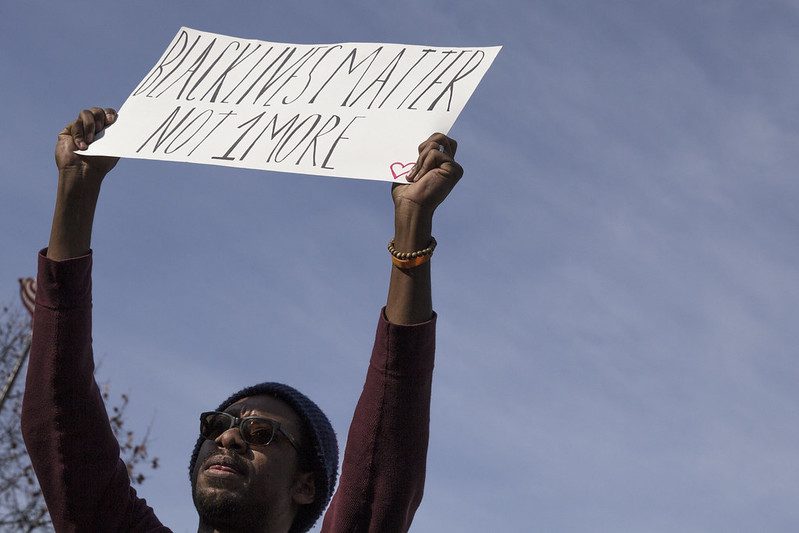
I couldn’t say how many Black Lives Matter marches, speeches, talks and fundraisers I have attended in New Mexico and South Carolina. We’ve been hitting the streets since 2014, shortly after the acquittal of Trayvon Martin’s assassin.
People tend to think of Black Lives Matter in association with major urban cities like New York or Oakland, or flashpoint towns like Ferguson. But there are roughly thirty official BLM chapters located across the country, and even more groups have held rallies of support in smaller cities and rural areas.
I mention the geographic diversity of the movement because there is a falsehood that BLM is restricted to urban areas, thus inevitably provokes “urban rioting.” But the systemic poverty and racism that can cause outrage is present in all corners of the country, and thus BLM’s mission to end these systems also resonates with Americans in every locale. If the movement’s policies to stop police brutality were adopted, there would be fewer wrongful deaths, and that would quell the anger that leads to rioting, rather than enhancing it.
Black Lives Matter is an overwhelmingly peaceful movement, committed to remain peaceful even in the face of hostility directed at us by federal troops and counter demonstrators, as seen recently in Portland, for example.
During my first seven years marching with the movement, I never saw violence, or even a gun, at a BLM rally. I saw nothing worse than heated and emotional exchanges between our protesters and hecklers in cars
But the Black Lives Matter movement was transformed irrevocably overnight on May 25th, 2020, the day George Floyd was videotaped slowly dying, while a cop pressed his knee on Floyd’s neck for eight minutes, forty-five seconds. The United States alongside several nations in the world erupted in protest. New white allies joined us in droves.
I was so caught up in the moment that it dazed me. Historical frustration reached a climactic point. Its roots ran deeper than Floyd, Taylor, or Tamir Rice. They ran back to slavery, segregation, two centuries of poverty, injustice and the weight of systemic racism — a concept which dramatically, finally, entered the national vocabulary.
But as always with progress, there was the fallout. In the weeks that followed Floyd’s murder Black Lives Matter demonstrators increased by thousands, but so too did the numbers of counter demonstrators, racist hecklers and white militia members carrying arms. Five times larger crowds also meant three times more hecklers and ten times the tension. The enhanced police presence also escalated tense situations.
Newspapers reported incidents of rioting following rallies, especially in Minneapolis. They provided conflicting accounts. Confused narratives ran amok. Some stories blamed the rioting on suspicious newbies, hooligans, and possible infiltrators undermining the movement by masquerading as BLM. Others lumped them all in together.
The BLM movement became an easy target for hatemongers who were encouraged by lies promulgated from the Oval Office. Talking heads began making false equivalences of the crimes of police brutality, George Floyd’s assassination, or Breonna Taylor’s death in her own home in the middle of the night, to that of property crimes and vandalism in the aftermath of a BLM rally. These distortions don’t portray what happens at the average BLM rally.
This is what happens in New Mexico, where I currently live: Heavily armed militias repeatedly dog racial justice protest rallies. Counter protestors descend with loudspeakers in trucks to shout us down, using racist slurs, exemplified in a video by the leader of New Mexico Cowboys for Trump. They carry signs that say “All Lives Matter” while brandishing weapons that end all lives. Their antagonistic intent is paper thin.
Yet there has only been a single shooting in conjunction with a New Mexico protest rally. It occurred on June 15, when an armed militiaman shot down a peaceful demonstrator.
Contrary to GOP propaganda, statistics show that 93 percent of BLM-related protests beginning in March, 2020 have been completely peaceful. One of the most publicized incidents of rioting in May, in which a fire erupted outside in Minneapolis police station — an incident which Trump used to vilify Black Lives Matter — has been revealed by the FBI to have likely been instigated by rightwing extremists.
When rioting does occur, we do our best to stop it.
Our commitment to nonviolence has been in keeping with the nonviolent principles of Martin Luther King. Nonviolence was King’s Christian ideal, and he always upheld it. But from his Christian perspective, he acknowledged that the real world wasn’t ideal. He specifically noted this about the fires that erupted in America’s impoverished Black communities throughout the late 1960’s, saying “rioting is socially destructive and self-defeating, but in the final analysis a riot in the language of the unheard. And what is it that America has failed to hear? It has failed to hear the plight of the poor.”
He opposed simple-minded vilification, or excess criminalization of frustrated rioters. He encouraged America to accept that the greater crime was its racism, its indifference, its ongoing incidents of police brutality and poverty levels which made rioting a sad inevitability.
King kept marching, and in doing so, faced threats from white supremacists who eventually murdered him. Like King, Black Lives matter won’t stop marching. We represent “the language of the unheard.” We will shout out and hit the streets until we’re heard.